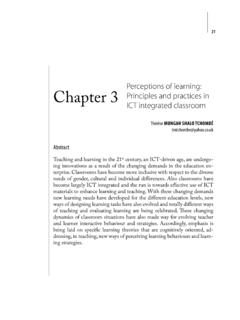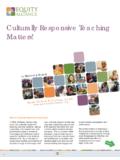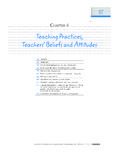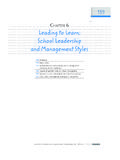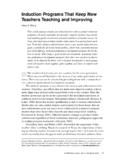Transcription of Teaching Smart People HowtoLearn - Egloos
1 Volume 4, Number 2,REFLECTIONS4 Teaching Smar t PeopleHowtoLearnChris ArgyrisAny company that aspires to succeed in the tougher business environment of the 1990smust rst resolve a basic dilemma: success in the marketplace increasingly dependson learning, yet most People don t know how to learn. What s more, those members ofthe organization that many assume to be the best at learning are, in fact, not very goodat it. I am talking about the well-educated, high-powered, high-commitment professionalswho occupy key leadership positions in the modern companies not only have tremendous dif culty addressing this learning di-lemma; they aren t even aware that it exists. The reason: they misunderstand what learn-ing is and how to bring it about.
2 As a result, they tend to make two mistakes in theirefforts to become a learning , most People de ne learning too narrowly as mere problem solving, so theyfocus on identifying and correcting errors in the external environment. Solving problemsis important. But if learning is to persist, managers and employees must also look need to re ect critically on their own behavior, identify the ways they often inad-vertently contribute to the organization s problems, and then change how they act. Inparticular, they must learn how the very way they go about de ning and solving problemscan be a source of problems in its own have coined the terms single loop and double loop learning to capture thiscrucial distinction.
3 To give a simple analogy: a thermostat that automatically turns on theheat whenever the temperature in a room drops below 68 degrees is a good example ofsingle-loop learning. A thermostat that could ask, Why am I set at 68 degrees? and thenexplore whether or not some other temperature might more economically achieve the goalof heating the room would be engaging in double-loop skilled professionals are frequently very good at single-loop learning. After all,they have spent much of their lives acquiring academic credentials, mastering one or anumber of intellectual disciplines, and applying those disciplines to solve real-world prob-lems. But ironically, this very fact helps explain why professionals are often so bad atdouble-loop simply, because many professionals are almost always successful at what theydo, they rarely experience failure.
4 And because they have rarely failed, they have neverlearned how to learn from failure. So whenever their single-loop learning strategies gowrong, they become defensive, screen out criticism, and put the blame on anyone andeveryone but themselves. In short, their ability to learn shuts down precisely at the mo-ment they need it the propensity among professionals to behave defensively helps shed light on thesecond mistake that companies make about learning. The common assumption is thatgetting People to learn is largely a matter of motivation. When People have the rightattitudes and commitment, learning automatically follows. So companiesfocus on creatingnew organizational structures compensation programs, performance reviews,corporatecultures, and the like that are designed to create motivated and committed effective double-loop learning is not simply a function of how People feel.
5 It is are ection of how they think that is, the cognitive rules or reasoning they use to design 1991 Harvard Business by The New York TimesSpecial Features/Syndication ArgyrisJames Bryant Conant ProfessorHarvard Business SchoolREFLECTIONS,Volume 4, Number 2 TeachingSmartPeopleHowtoLearn ARGYRIS5and implement their actions. Think of these rules as a kind of master program storedin the brain, governing all behavior. Defensive reasoning can block learning even whenthe individual commitment to it is high, just as a computer program with hidden bugscan produce results exactly the opposite of what its designers had can learn how to resolve the learning dilemma. What it takes is to makethe ways managers and employees reason about their behavior a focus of organizationallearning and continuous improvement programs.
6 Teaching People how to reason abouttheir behavior in new and more effective ways breaks down the defenses that of the examples that follow involve a particular kind of professional: fast-trackconsultants at major management consulting companies. But the implications of my ar-gument go far beyond this speci c occupational group. The fact is, more and more jobs no matter what the title are taking on the contours of knowledge work. People at alllevels of the organization must combine the mastery of some highly specialized technicalexpertise with the ability to work effectively in teams, form productive relationships withclients and customers, and critically re ect on and then change their own organizationalpractices.
7 And the nuts and bolts of management whether of high-powered consultantsor service representatives, senior managers or factory technicians increasingly consistsof guiding and integrating the autonomous but interconnected work of highly Professionals Avoid LearningFor 15 years, I have been conducting in-depth studies of management consultants. I de-cided to study consultants for a few simple reasons. First, they are the epitome of thehighly educated professionals who play an increasingly central role in all all of the consultants I ve studied have MBAs from the top three or four schools. They are also highly committed to theirwork. For instance, at one company, more than 90% of theconsultants responded in a survey that they were highlysatis ed with their jobs and with the also assumed that such professional consultants wouldbe good at learning.
8 After all, the essence of their job is toteach others how to do things differently. I found, however,that these consultants embodied the learning dilemma. Themost enthusiastic about continuous improvement in theirown organizations, they were also often the biggest obstacleto its complete long as efforts at learning and change focused on external organizational factors job redesign, compensation programs, performance review, and leadership training theprofessionals were enthusiastic participants. Indeed, creating new systems and structureswas precisely the kind of challenge that well-educated, highly motivated yet the moment the quest for continuous improvement turned to the profession-als ownperformance, something went wrong.
9 It wasn t a matter of bad attitude. Theprofessionals commitment to excellence was genuine, and the vision of the company wasclear. Nevertheless, continuous improvement did not persist. And the longer the contin-uous improvement efforts continued, the greater the likelihood that they would produceever-diminishing happened? The professionals began to feel embarrassed. They were threatenedby the prospect of critically examining their own role in the organization. Indeed, becausethey were so well paid (and generally believed that their employers were supportive andfair), the idea that their performance might not be at its best made them feel from being a catalyst for real change, such feelings caused most to react defen-sively.
10 They projected the blame for any problems away from themselves and onto whatthey said were unclear goals, insensitive and unfair leaders, and stupid this example. At a premier management consulting company, the managerof a case team called a meeting to examine the team s performance on a recent consultingproject. The client was largely satis ed and had given the team relatively high marks, butProfess ionals embody the learningdilemma: they are enthusiasticabout continuous improvement and often the biggest obstacle toits s uccess .Volume 4, Number 2,REFLECTIONST eachingSmartPeopleHowtoLearn ARGYRIS6the manager believed the team had not created the value added that it was capable of andthat the consulting company had promised.

